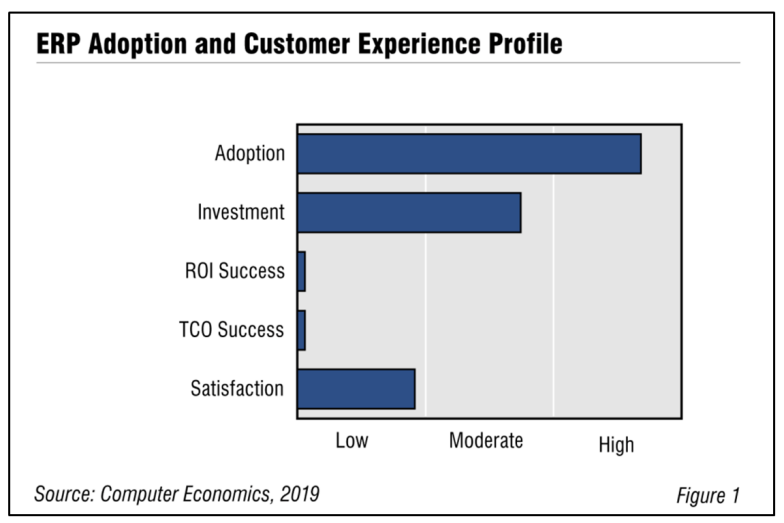Enterprise resource planning (ERP) systems remain one of the most-adopted technologies we track, with about 80% of companies now using these systems. But it’s not all sunshine and roses: Despite the adoption rate, ERP continues to have a poor track record for total cost of ownership, return on investment, and overall user satisfaction. All the recent ERP advancements cannot hide the fact that ERP systems are complex and difficult deployments that touch a large percentage of business processes in an organization.
Figure 1 from our full report, ERP Adoption Trends and Customer Experience, compares ERP against 14 other business technologies on five metrics: adoption rate, investment rate, ROI success rate, TCO success rate, and satisfaction rate. Among those organizations that have adopted an ERP system, the percentage that are at least breaking even on their investments within a two-year period is low when compared with other technologies in the study. The TCO success rate is also low. We define this rate as the percentage of adopters that come in on budget, or at less than budget, for implementation and ongoing support costs. The customer satisfaction rate for ERP is also low compared with other technologies in our study.

ERP is the transactional backbone and primary system of record for many organizations and has been so for some time. As such, many companies have been nursing legacy ERP systems for years, in some cases even decades. With the success of early cloud investments, it appears many organizations believe this is the perfect time to upgrade those legacy ERP systems.
“Low ROI and satisfaction ratings don’t mean that ERP systems are not worth the investment,” said Tom Dunlap, director of research of Computer Economics, a research and analyst firm based in Irvine, Calif. “It just means that ERP deployments are complex and often take longer to show their returns. A poor ERP deployment can set an organization back as it struggles to transform business processes and win user trust.”
As the TCO numbers show, cost overruns are a major issue with ERP. But risks with ERP go beyond the potential for cost overruns. There are at least three other types of risks with ERP systems:
-
- Functionality risks: There is a possibility that key requirements of the organization may not be met by the new system, either because they were not adequately defined during the planning phase or because the organization’s business model or processes may change in the future.
- Adoption risks: The organization’s employees may resist use of the new system. Parts of the old system may be retained and the new system may not be fully used, or people may develop their own informal systems to work around the new system.
- Benefit risks: Technically, the new system may be implemented, but the organization may not realize all of the planned-for benefits.
Our full report helps IT executives understand how aggressively their peers are investing in ERP and the risks and rewards presented by those investments. We report worldwide adoption and investment rates by sector and organization size. We also measure customer experience in terms of the success rates for return on investment (ROI) and total cost of ownership (TCO). We identify the functional areas where organizations are planning or considering making new investments in ERP. We also examine where ERP systems are deployed as well as their typical age and length of time between version upgrades. We wrap up with our recommendations for improving the ROI of ERP.
This Research Byte is a brief overview of our report on this subject, ERP Adoption Trends and Customer Experience. The full report is available at no charge for Avasant Research subscribers, or it may be purchased by non-subscribers directly from our website (click for pricing).

